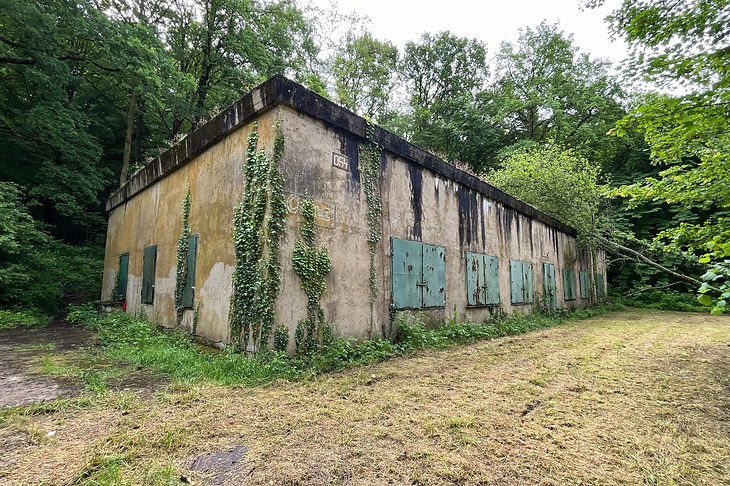
Wolfsschlucht II buildings 19 to 22
Office buildings to the south of Wolfsschlucht II main area

Wolfsschlucht II buildings 19 to 22 site overview

What to see
If there was ever a bunker site which highlighted Germany’s waste of valuable resources, then the Wolfsschlucht II, around Margival in northern France, was it.
Created to be one of Hitler’s Fuhrer Headquarters and a command base for his generals, this site features one of the largest numbers of concrete structures constructed in one area of occupied France.
From September 1942 to 1944 around 22,000 workers constructed over 800 buildings here, including over 150 defensive positions, 230+ anti-aircraft and searchlight posts, personnel shelters, storage structures, office buildings, generator bunkers, and heavy-duty command bunkers. There’s even a swimming pool.
The inner site covered around 12km with building 001, the Fuhrer HQ, at the heart of it.
Surrounding the central position were over 20 anti-aircraft gun sites and several searchlight positions, while the nearby villages of Laffaux, Mailly-Urcel, Margival, Neuville-sur-Margival, Terny-Sorny, Vauxaillon, and Vregny all became defensive fortresses and troops positions, creating a ‘ring of fire’ around the Fuhrer HQ.
Several underground quarries were also dug for storage. It’s estimated that the total area of the site, with its supporting buildings, covered over 80 square kilometres.
In total, Hitler spent just one day at the location.
On June 17, 1944, he met with Field Marshalls Erwin Rommel and Gerd Von Rundstedt to plan Germany’s response to the Allied landings in Normandy earlier in the month. While he was there the site was subjected to an air raid and he left shortly afterwards.
Wolfsschlucht translates to English as ‘Wolf Canyon or Gorge’ and links to Hitler’s codename of ‘Grey Wolf’ and the fact the site is located in wooded valley.
The area, to the north east of Soissons, also boasted a 650m long railway tunnel, buried 30m underground, which was the perfect location for Hitler’s private train to seek shelter from Allied attacks.
It was the second FHQ built, the first Wolfsschlucht site on the Belgium-France border was where Hitler spent most of June 1940 as he waited for the conclusion of the battle of France – May 10 to June 25, 1940).
Following the withdrawal of the garrison at Margival in late August 1944, US forces from the 3rd Armoured Division and 1st Infantry Division passed through the area but it was the 602nd Engineer Camouflage Battalion who are credited with its ‘capture’ after entering the heart of the site to inspect and survey the buildings.
It was the first of Hitler’s headquarters to fall into Allied hands.
Following the conclusion of the Second World War, the site became a French military base and was later used by NATO as a communications centre, which has ensured that many of the buildings have remained in good condition.
Today the site is open to the public and still boasts an incredible number of remaining structures which can be visited with care. Many of the outer lying buildings stand on private farmland or are incorporated into private properties, but the heart of the Wolfsschlucht II location can be viewed.
Office buildings to the south of Wolfsschlucht II main area
Building 019 – Light bunker
Post war was renumbered as 052 and named Caen.
Building 020 – Light bunker
Post war was renumbered as 054 and named Caen.
Building 021 – Light bunker
Post war was renumbered as 052 and named Sous-Lieutenant Busin.
Building 022 – Light bunker
Post war was renumbered as 057 and named Le Matz.
Gallery




